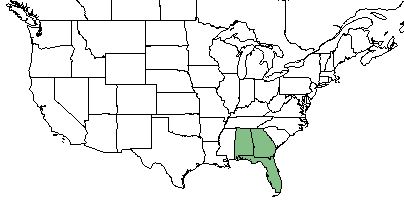Difference between revisions of "Dalea albida"
(→Taxonomic Notes) |
|||
| Line 30: | Line 30: | ||
==Ecology== | ==Ecology== | ||
===Habitat=== <!--Natural communities, human disturbed habitats, topography, hydrology, soils, light, fire regime requirements for removal of competition, etc.--> | ===Habitat=== <!--Natural communities, human disturbed habitats, topography, hydrology, soils, light, fire regime requirements for removal of competition, etc.--> | ||
| − | ''D. albida'' is found in pinelands.<ref name="Weakley 2015"/> It also occurs in central Florida glades where it has a 5% frequency.<ref name="Orzell & Bridges 2006">Orzell SL, Bridges EL (2006) Floristic composition of the south-central Florida dry prairie landscape. Florida Ecosystem 1(3):123-133.</ref> It was found to be among the most cold-hardy legumes found in southern Georgia, where it persists through repeated frosts and was present in January and February field surveys.<ref name = "Hainds 1995"> Hainds, M. J. (1995). Legume population dynamics in a frequently burned longleaf pine-wiregrass ecosystem. Master of Science Thesis, Auburn University. 111 pages.</ref> | + | ''D. albida'' is found in pinelands.<ref name="Weakley 2015"/> It also occurs in central Florida glades where it has a 5% frequency.<ref name="Orzell & Bridges 2006">Orzell SL, Bridges EL (2006) Floristic composition of the south-central Florida dry prairie landscape. Florida Ecosystem 1(3):123-133.</ref> It was found to be among the most cold-hardy legumes found in southern Georgia, where it persists through repeated frosts and was present in January and February field surveys.<ref name = "Hainds 1995"> Hainds, M. J. (1995). Legume population dynamics in a frequently burned longleaf pine-wiregrass ecosystem. Master of Science Thesis, Auburn University. 111 pages.</ref> It is found in dry-mesic to wet-mesic prairies.<ref name= "Orzell & Bridges 2006"/> |
===Phenology=== <!--Timing off flowering, fruiting, seed dispersal, and environmental triggers. Cite PanFlora website if appropriate: http://www.gilnelson.com/PanFlora/ --> | ===Phenology=== <!--Timing off flowering, fruiting, seed dispersal, and environmental triggers. Cite PanFlora website if appropriate: http://www.gilnelson.com/PanFlora/ --> | ||
Revision as of 16:31, 25 April 2019
| Dalea albida | |
|---|---|
| Scientific classification | |
| Kingdom: | Plantae |
| Division: | Magnoliophyta - Flowering plants |
| Class: | Magnoliopsida - Dicots |
| Order: | Fabales |
| Family: | Fabaceae |
| Genus: | Dalea |
| Species: | D. albida |
| Binomial name | |
| Dalea albida Torr. & A. Gray | |

| |
| Natural range of Dalea albida from USDA NRCS Plants Database. | |
Common Name: White-tassels[1][2]
Contents
Taxonomic Notes
Synonyms: D. carnea var. albida (Torrey & A. Gray) Barneby; Petalostemon albidus (Torrey & A. Gray) Small[1][2]
Description
Dalea albida is a dioecious perennial that grows as a forb/herb or a subshrub.[2]
Distribution
This species occurs from eastern Georgia, westward to southeast Alabama, and southward to northern peninsular Florida.[1]
Ecology
Habitat
D. albida is found in pinelands.[1] It also occurs in central Florida glades where it has a 5% frequency.[3] It was found to be among the most cold-hardy legumes found in southern Georgia, where it persists through repeated frosts and was present in January and February field surveys.[4] It is found in dry-mesic to wet-mesic prairies.[3]
Phenology
In the southeastern and mid-Atlantic United States, flowering occurs from July through November.[1]
Conservation and Management
Cultivation and restoration
Photo Gallery
References and notes
- ↑ 1.0 1.1 1.2 1.3 1.4 Weakley AS (2015) Flora of the Southern and Mid-Atlantic States. Chapel Hill, NC: University of North Carolina Herbarium.
- ↑ 2.0 2.1 2.2 USDA NRCS (2016) The PLANTS Database (http://plants.usda.gov, 02 February 2018). National Plant Data Team, Greensboro, NC 27401-4901 USA.
- ↑ 3.0 3.1 Orzell SL, Bridges EL (2006) Floristic composition of the south-central Florida dry prairie landscape. Florida Ecosystem 1(3):123-133.
- ↑ Hainds, M. J. (1995). Legume population dynamics in a frequently burned longleaf pine-wiregrass ecosystem. Master of Science Thesis, Auburn University. 111 pages.